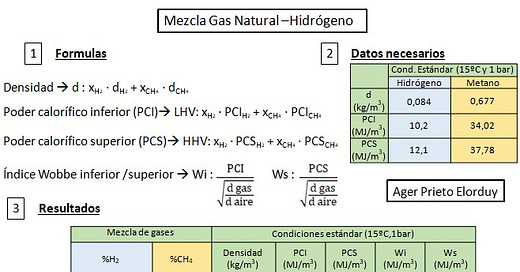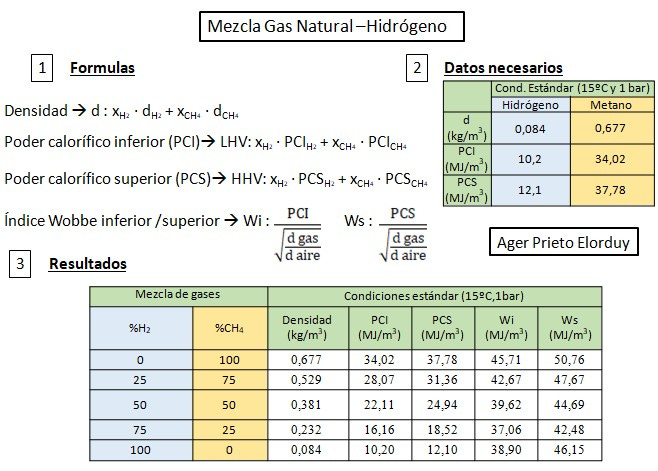33) Indice Wobbe - Variación en la mezcla Hidrógeno-Gas Natural
Al tratarse de dos gases con diferentes características es necesario saber si pueden mezclarse para dar una combustión adecuada.
Para ello, Goffredo Wobbe observo en 1927 que los gases con valores similares del Índice de Wobbe podían intercambiarse en procesos de calentamiento.
¿Pero para que sirve el Índice de Wobbe?
Se utiliza para comparar la producción de energía de combustión de diferentes gases combustibles sin conocer su composición detallada (algo habitual en el gas natural, dado que las concentraciones de los gases que conforman el gas natural (metano/etano/ propano/butano), no son constantes durante todo el suministro).
¿Por qué es importante el Índice de Wobbe?
El WI es un factor crítico para minimizar el impacto de fluctuaciones en el suministro de gas combustible y aumentar la eficiencia del sistema de combustión porque los equipos diseñados para operar en un cierto WI generalmente tienen una tolerancia de solo ~5% (según mis cálculos, permitiría una mezcla de 20% H₂).
Si dos combustibles tienen índices de Wobbe idénticos para la misma presión y los ajustes de válvula dados, la energía la salida también será idéntica.
¿Cómo se calcula el Índice de Wobbe?
WI se define como la relación del poder calorífico superior (High Heating Value, HHV) por unidad de medida del gas a la raíz cuadrada de la densidad relativa del gas (definido como densidad del gas/densidad del aire seco).
En la imagen adjunta podréis observar las formulas necesarias para calcular el índice de Wobbe.
Destacar que la densidad de una mezcla de gases se puede calcular, sabiendo los porcentajes del gas respecto a la mezcla y la densidad de cada gas.
Por último, el poder calorífico inferior, en ingles Low Heating Value (LHV), hace referencia a la cantidad total de calor desprendido en la combustión completa de 1 kg de combustible sin contar la parte correspondiente al calor latente del vapor de agua de la combustión, ya que no se produce cambio de fase, y se expulsa como vapor.
En un hipotético caso, donde el blending de hidrógeno sobre la red de gas natural se haga realidad, de entrada, la progresiva presencia de hidrógeno en el gas natural, nos quitará poder calorífico. Por lo que, será necesario bombear más gas, para obtener la misma cantidad de energía al quemar el combustible en nuestras calderas domesticas.
33) Wobbe Index - Variation in the Hydrogen-Natural Gas mixture
As they are two gases with different characteristics, it is necessary to know if they can be mixed to give proper combustion.
To do this, Goffredo Wobbe observed in 1927 that gases with similar values of the Wobbe Index could be exchanged in heating processes.
But what is the Wobbe Index for?
It is used to compare the combustion energy production of different fuel gases without knowing their detailed composition (something common in natural gas, since the concentrations of the gases that make up natural gas (methane/ethane/propane/butane), do not are constant throughout the supply).
Why is the Wobbe Index important?
WI is a critical factor in minimizing the impact of fluctuations in fuel gas supply and increasing combustion system efficiency because equipment designed to operate at a certain WI typically has a tolerance of only ~5% (by my calculations, would allow a 20% H₂ mix).
If two fuels have identical Wobbe indices for the same pressure and given valve settings, the power output will also be identical.
How is the Wobbe Index calculated?
WI is defined as the ratio of the High Heating Value (HHV) per unit measure of the gas to the square root of the relative density of the gas (defined as gas density/dry air density).
In the attached image you can see the necessary formulas to calculate the Wobbe index.
Note that the density of a mixture of gases can be calculated, knowing the percentages of the gas with respect to the mixture and the density of each gas.
Finally, the lower calorific value, in English Low Heating Value (LHV), refers to the total amount of heat released in the complete combustion of 1 kg of fuel without counting the part corresponding to the latent heat of the combustion water vapor. , since no phase change occurs, and it is expelled as vapor.
In a hypothetical case, where the blending of hydrogen on the natural gas network becomes a reality, from the outset, the progressive presence of hydrogen in the natural gas will take away its calorific value. Therefore, it will be necessary to pump more gas, to obtain the same amount of energy when burning the fuel in our domestic boilers.






